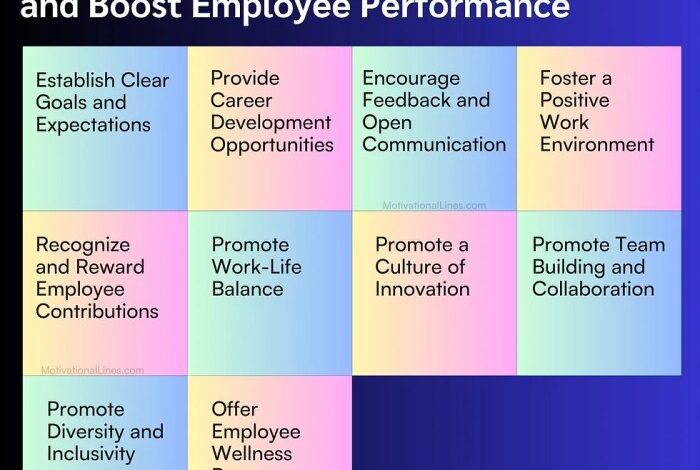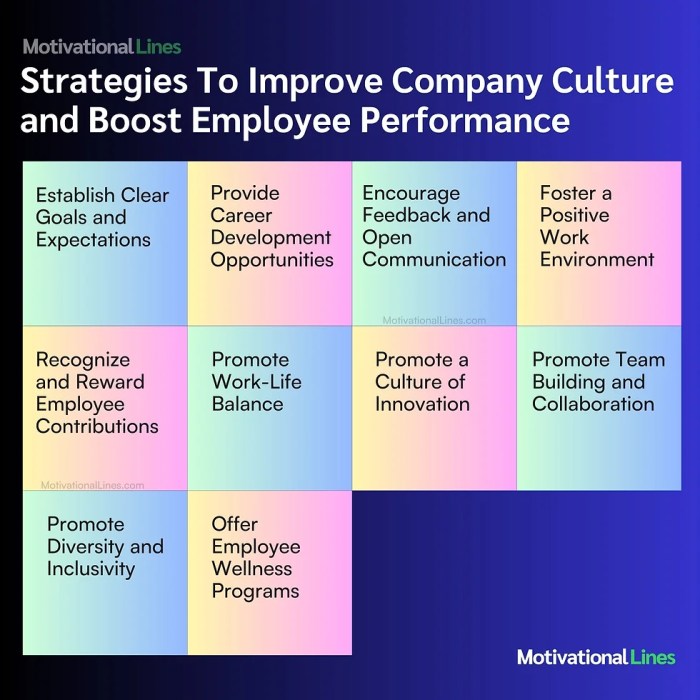
Company culture matters to workers. It’s more than just a vibe; it’s the bedrock upon which employee well-being, satisfaction, and productivity are built. This exploration delves into the crucial role company culture plays in shaping the employee experience, from defining its core elements to understanding its impact on worker perceptions and strategies for fostering a positive environment. We’ll examine how diverse factors like employee roles, generational differences, and even remote work can influence culture, and what challenges might arise along the way.
Understanding how company culture impacts workers is essential for businesses seeking to attract and retain top talent. A strong, positive culture fosters engagement, productivity, and job satisfaction. Conversely, a negative culture can lead to burnout, decreased retention, and ultimately, reduced profitability. This analysis will highlight effective strategies for building a positive company culture and the importance of measuring its impact on worker well-being.
Defining Company Culture
Company culture is the personality of a workplace. It’s the shared values, beliefs, and behaviors that shape how employees interact with each other, customers, and the company itself. A strong company culture fosters a positive and productive work environment, boosting employee morale, engagement, and ultimately, business success. A well-defined culture provides a clear framework for decision-making, communication, and problem-solving, making the company a more attractive place to work and contribute to.A positive work environment is characterized by respect, trust, and open communication.
Employees feel valued and supported, leading to increased job satisfaction, reduced stress, and higher retention rates. Conversely, a negative culture can lead to low morale, high turnover, and decreased productivity. Understanding the elements that contribute to a positive or negative culture is crucial for building a thriving workplace.
Defining a Strong Company Culture
A strong company culture is built on shared values and beliefs that are consistently reinforced through actions and decisions. This creates a sense of belonging and purpose for employees, encouraging them to align their work with the company’s mission and vision. It fosters a sense of community, encouraging collaboration and teamwork, while also enabling individuals to thrive in their roles.
Ultimately, a strong culture improves performance and promotes long-term success.
Key Elements of a Positive Work Environment
Several key elements contribute to a positive work environment. These include open communication channels, clear expectations, and opportunities for growth and development. Employees who feel heard and respected are more likely to be engaged and productive. Furthermore, fair and consistent treatment, along with recognition for achievements, significantly contribute to a positive work experience. Strong leadership, providing mentorship and support, is critical to fostering a positive culture.
Types of Company Cultures
Different company cultures cater to different organizational structures and values. A hierarchical culture is characterized by a clear chain of command and defined roles. This structure can be effective in providing clear direction and accountability. In contrast, a flat organizational structure promotes a more collaborative environment, with less emphasis on formal titles and hierarchies. This can foster creativity and innovation, while also potentially leading to less clear decision-making processes.
Company culture is undeniably crucial for worker satisfaction, and it’s more than just free snacks and ping-pong tables. A supportive environment fosters creativity and productivity, but even the most amazing company culture can’t fully shield employees from industry shifts. Take a look at how the changing media landscape is affecting journalists, as exemplified by the struggles of adapting to new technology, like the inadequacy of iPads to adequately support the demands of journalism, as discussed in this insightful article: ipads not soft enough to cushion journalisms hard landing.
Ultimately, strong company culture remains essential to navigating those challenges and helping employees thrive.
A collaborative culture emphasizes teamwork and shared goals. This fosters a sense of community and shared responsibility. A balanced approach is crucial for success, recognizing the strengths of each type and tailoring them to the company’s specific needs and goals.
Evaluating Company Culture Through Employee Feedback
Gathering employee feedback is essential for understanding and evaluating the company culture. Surveys, focus groups, and one-on-one discussions provide valuable insights into employee perceptions of the work environment. Analyzing this feedback allows companies to identify areas for improvement and make adjustments to enhance employee satisfaction and engagement. This data-driven approach enables proactive measures to address any negative aspects and promote a more positive culture.
Common Cultural Values that Resonate with Workers
A range of values resonates with workers, fostering a strong sense of connection with the company. Honesty, integrity, and respect for others are fundamental to a positive workplace environment. Employees value fairness and transparency in decision-making processes, which builds trust and confidence. A culture that emphasizes work-life balance and well-being fosters a healthier and more productive workforce.
Finally, a company culture that prioritizes learning and development empowers employees to grow and contribute their best work.
Impact of Culture on Employee Well-being: Company Culture Matters To Workers
Company culture significantly impacts employee well-being, influencing everything from job satisfaction and retention to engagement and productivity. A positive, supportive culture fosters a healthy work environment where employees feel valued, respected, and empowered. Conversely, a toxic or unsupportive culture can lead to stress, burnout, and decreased overall well-being. Understanding the nuances of this relationship is crucial for creating thriving work environments.A strong company culture isn’t just about ping-pong tables and free snacks; it’s about the underlying values, beliefs, and behaviors that shape how people interact and work together.
These factors deeply affect employees’ sense of belonging, purpose, and safety within the organization. A culture that prioritizes open communication, collaboration, and recognition can lead to higher job satisfaction and improved employee well-being.
Correlation between Company Culture and Employee Job Satisfaction
Employee job satisfaction is directly correlated with a positive company culture. Employees in organizations with strong cultures, characterized by trust, respect, and open communication, report higher levels of job satisfaction. This satisfaction stems from feeling valued, understood, and supported by their colleagues and management. Conversely, a negative or toxic culture often leads to dissatisfaction, impacting morale and productivity.
Company culture undeniably impacts employee satisfaction. A recent case study, like the one found in the google belgian papers sort it out article, highlights how internal processes and management styles directly affect worker morale and productivity. Ultimately, a positive and supportive company culture is key to attracting and retaining top talent.
For instance, a company that prioritizes transparency and employee input often sees higher satisfaction ratings compared to one that operates with secrecy and micromanagement.
Impact of a Positive Company Culture on Employee Retention
A positive company culture significantly influences employee retention. Employees who feel valued, supported, and engaged are more likely to stay with an organization long-term. Factors like recognition programs, opportunities for professional development, and a sense of community contribute to a positive experience, increasing the likelihood of employees remaining loyal. This reduces the cost and disruption associated with high employee turnover.
For example, companies with strong mentorship programs and opportunities for career advancement tend to have lower turnover rates.
Factors Contributing to Employee Burnout in a Negative Work Environment
Several factors contribute to employee burnout in negative work environments. These include excessive workloads, lack of support from management, unclear expectations, a culture of negativity, and a lack of work-life balance. Employees subjected to constant pressure, criticism, and lack of autonomy are more vulnerable to burnout. High levels of stress and anxiety, resulting from these negative factors, can significantly impact employee well-being.
For example, organizations with strict and inflexible policies regarding work hours or time off often see increased burnout rates among their employees.
How Company Culture Influences Employee Engagement and Productivity
Company culture significantly impacts employee engagement and productivity. A positive culture fosters a sense of belonging and purpose, motivating employees to contribute their best work. Conversely, a negative culture can demotivate employees, leading to decreased engagement and productivity. Employees in supportive environments tend to be more innovative and creative, resulting in higher levels of output and efficiency.
For example, companies that encourage collaboration and knowledge sharing tend to see higher levels of innovation and productivity than those that operate in isolation.
Examples of How Different Cultural Norms Affect Worker Motivation
Different cultural norms can significantly impact worker motivation. A culture that values individual achievement might motivate employees driven by personal recognition, while a culture that emphasizes teamwork might inspire those who thrive in collaborative environments. Recognition and rewards systems should be aligned with the cultural values of the workforce for maximum impact. For example, in some cultures, public recognition is highly valued, while in others, private acknowledgment is preferred.
Worker Perceptions of Company Culture
Company culture isn’t just a set of values; it’s a lived experience. How employees perceive and interact with those values significantly impacts their engagement, satisfaction, and overall well-being. Understanding these perceptions is crucial for fostering a positive and productive work environment.Worker perceptions are multifaceted and deeply influenced by various factors. Employee roles, cultural backgrounds, communication styles, and leadership approaches all play a vital role in shaping these perceptions.
Furthermore, generational differences often lead to varying interpretations of company values and expectations.
Diverse Perspectives on Cultural Importance
Different roles within a company often bring different perspectives on the importance of company culture. Entry-level employees might prioritize a supportive and mentoring environment, while senior management might value a culture that fosters innovation and strategic thinking. A marketing team might emphasize a collaborative and creative atmosphere, while a technical team might prioritize a culture that encourages problem-solving and technical excellence.
These diverse perspectives highlight the need for a culture that is inclusive and caters to the needs of all employees.
Cultural Differences and Value Acceptance
Cultural differences can significantly affect how employees accept and interpret company values. For example, employees from collectivist cultures might prioritize team harmony and group goals over individual achievement, while those from individualistic cultures might place a greater emphasis on personal recognition and autonomy. Companies must strive to understand and respect these differences, tailoring their communication and practices to resonate with the various cultural backgrounds of their workforce.
This involves promoting cultural sensitivity and creating an environment where employees feel valued and respected, regardless of their background.
Communication and Perceptions of Company Culture
Clear and consistent communication is fundamental in shaping employee perceptions of company culture. Open communication channels, regular feedback mechanisms, and transparent leadership are crucial elements. When employees feel heard and informed, they are more likely to feel connected to the company’s values and goals. Conversely, a lack of communication can lead to misunderstandings, rumors, and a sense of disconnect, undermining the desired company culture.
Leadership Styles and Company Culture
Leadership styles have a profound impact on the overall company culture. Transformational leaders, for example, inspire and motivate employees by articulating a compelling vision and fostering a sense of shared purpose. Servant leaders focus on supporting employees and empowering them to achieve their full potential, leading to a collaborative and supportive work environment. On the other hand, autocratic leaders, while potentially efficient in specific situations, can stifle creativity and autonomy, potentially leading to a less engaged and motivated workforce.
The specific leadership style should align with the overall values and goals of the company, creating a harmonious and productive atmosphere.
Generational Perceptions of Company Culture
| Generation | Values | Communication Style | Work Expectations |
|---|---|---|---|
| Millennials | Work-life balance, flexibility, social impact, and a strong sense of purpose are paramount. They value opportunities for professional growth and development, and they often prioritize companies with strong ethical values. | Open, direct, and digitally-driven. They often prefer asynchronous communication and readily embrace technology for collaboration. | They expect a clear path for advancement, opportunities for skill development, and a supportive work environment that values their contributions. |
| Gen Z | Authenticity, diversity, inclusion, and a positive work environment are crucial. They value transparency, purpose-driven work, and companies that align with their values. | Highly digitally-oriented, utilizing multiple platforms for communication and collaboration. They appreciate clear expectations and prefer concise, direct communication. | They seek a work-life balance, a strong sense of community, and opportunities to learn and grow. Flexibility and remote work options are highly valued. |
| Baby Boomers | Stability, loyalty, and a clear structure are key values. They often prioritize experience, and strong leadership, and value a hierarchical structure. | Often prefer face-to-face interactions and direct communication. They tend to value established procedures and clear communication channels. | They expect stability, a clear career path, and a respectful work environment that recognizes their experience and contributions. |
The table above provides a general overview; individual experiences and preferences may vary within each generation.
Strategies for Building a Positive Culture
Cultivating a positive company culture is not just about creating a pleasant atmosphere; it’s a strategic imperative for attracting, retaining, and motivating top talent. A positive culture fosters innovation, increases productivity, and boosts employee morale, ultimately contributing to the overall success of the organization. Understanding the key strategies to build and maintain such a culture is crucial for leaders and managers.A strong company culture is built on a foundation of shared values, clear communication, and opportunities for growth.
It’s about actively creating an environment where employees feel valued, respected, and empowered to contribute their best work. This approach not only improves employee well-being but also directly impacts the company’s bottom line.
Demonstrating Effective Strategies for Fostering a Positive Work Environment
Creating a positive work environment goes beyond simply providing a comfortable workspace. It involves actively listening to employee concerns, valuing diverse perspectives, and fostering a sense of belonging. Transparency and open communication channels are key to ensuring employees feel heard and understood. Leadership should model the desired behavior and actively promote a culture of respect and collaboration.
Cultivating a Culture of Open Communication and Feedback
Open communication is essential for a healthy work environment. Establishing clear channels for feedback—both positive and constructive—allows employees to voice their opinions and concerns without fear of retribution. Regular team meetings, suggestion boxes, and anonymous feedback mechanisms can be valuable tools. Encouraging active listening and responding to feedback promptly demonstrates a commitment to employee input.
Company culture is a huge deal for workers, impacting everything from job satisfaction to productivity. A recent example of how company culture can attract specific demographics is HTC’s new marketing campaign, which appears to be targeting female consumers with its “rhyme” strategy. Check out how HTC’s rhyme flirts with female demographic to see how it’s playing out.
Ultimately, a company’s approach to culture directly affects worker retention and recruitment in the long run.
Recognizing and Rewarding Employee Contributions
Recognizing and rewarding employees for their contributions is vital for motivation and engagement. Formal recognition programs, such as employee of the month awards, can highlight outstanding achievements. Informal appreciation, such as verbal praise or handwritten notes, can also be highly effective. Recognition should be tied to specific accomplishments and should be delivered consistently and fairly. Financial incentives, such as bonuses or raises, can also serve as powerful motivators.
Creating Opportunities for Employee Growth and Development
Investing in employee growth and development is a significant component of a positive company culture. Providing opportunities for training, mentorship, and skill enhancement demonstrates a commitment to employee advancement. Offering opportunities for professional development, such as conferences or workshops, can foster a sense of investment in the employee’s future within the company. Career advancement plans, internal mobility, and clear paths for promotion can also increase employee engagement.
Company Activities to Enhance a Positive Culture
Regular team-building activities, social events, and volunteer opportunities can strengthen camaraderie and build a sense of community among employees. These activities foster a more relaxed and enjoyable work environment, which often translates into increased productivity and better overall employee relations. Examples include team lunches, company outings, or volunteering at local charities. Encouraging participation in these events is essential for success.
Challenges in Cultivating Company Culture
Cultivating a strong and positive company culture is a multifaceted endeavor, demanding consistent effort and attention. However, various challenges can hinder its development and maintenance. These obstacles, ranging from geographical dispersion to economic fluctuations, necessitate careful consideration and proactive strategies for overcoming them.Maintaining a unified and consistent company culture across multiple locations presents a significant hurdle. Different teams, offices, or branches might develop unique sub-cultures, leading to inconsistencies in values, communication styles, and overall workplace atmosphere.
This can create a sense of disconnect and inequity among employees, impacting their sense of belonging and motivation.
Maintaining Consistency Across Locations
Geographical dispersion often complicates the process of maintaining a consistent company culture. Different time zones, local customs, and varying regulatory environments can create challenges in implementing and enforcing company-wide policies and procedures. For instance, a company with offices in multiple countries may encounter difficulties in ensuring that their employee handbooks, dress codes, or communication protocols are universally understood and followed.
Strong leadership and effective communication channels are crucial to navigating these differences and ensuring a shared sense of purpose and identity.
Impact of Remote Work on Company Culture
Remote work has significantly altered the dynamics of company culture. The absence of face-to-face interaction can lead to a loss of spontaneous collaboration, informal networking opportunities, and the development of a shared sense of camaraderie. Furthermore, it can be harder to foster a sense of belonging and shared identity among employees who are geographically dispersed. Companies must actively invest in virtual team-building activities, utilize technology for seamless communication, and implement policies that encourage collaboration and connection.
Incorporating Diverse Perspectives into Company Culture
Building a company culture that embraces diversity and inclusion is a critical aspect of modern workplace practices. However, incorporating diverse perspectives into the company culture can be challenging. Preconceived notions, communication barriers, and lack of understanding can impede the effective integration of diverse viewpoints. Companies must actively promote inclusivity through training programs, mentorship initiatives, and creating an environment where all employees feel comfortable expressing their opinions and perspectives.
Impact of Organizational Changes on Company Culture
Organizational changes, such as mergers, acquisitions, or restructuring, can have a significant impact on company culture. These changes often disrupt established routines, create uncertainty, and challenge the existing norms and values. For example, a merger can result in clashes between two different company cultures, leading to confusion, conflict, and a decline in employee morale. Effective communication, clear leadership, and a focus on integration strategies are vital during these transitions.
Economic Factors and Worker Perception
Economic factors can significantly influence how workers perceive company culture. During economic downturns, workers may perceive a lack of investment in their well-being, as evidenced by reduced training opportunities, salary freezes, or hiring freezes. Conversely, economic prosperity might foster a culture of abundance and growth. Companies must proactively manage communication and demonstrate that they are committed to their employees’ welfare, regardless of the prevailing economic conditions.
Measuring the Effectiveness of Company Culture Initiatives

Company culture isn’t something you can simply implement and expect instant results. It’s a living entity, constantly evolving in response to employee interactions and feedback. To ensure initiatives are truly impactful, you need a robust system for measuring their effectiveness. This allows for continuous improvement and adaptation, ensuring the culture aligns with the company’s goals.Understanding how employees perceive and experience the culture is crucial for its ongoing success.
This necessitates a structured approach to gathering and analyzing feedback, alongside the implementation of metrics that track progress. The effectiveness of any cultural initiative depends heavily on the responsiveness and continuous adaptation to the feedback and metrics gathered.
Methods for Assessing the Effectiveness of Cultural Initiatives
Various methods can be employed to gauge the success of company culture initiatives. These include regular employee surveys, focus groups, and observation of interactions within the workplace. Quantitative data from these assessments can be used to track key performance indicators (KPIs) and identify areas for improvement.
Collecting Employee Feedback Regarding Company Culture, Company culture matters to workers
Gathering employee feedback is paramount. Regular pulse surveys, encompassing specific questions about the initiatives, provide a quick snapshot of employee sentiment. These surveys can be administered through online platforms or by in-person discussions with managers. Open-ended questions encourage employees to elaborate on their experiences, while structured questions allow for quantifiable data analysis. Focus groups offer a deeper understanding of employee perspectives.
Analyzing Employee Sentiment and Engagement Data
Sentiment analysis of employee feedback provides valuable insights. Tools can identify positive, negative, or neutral sentiments expressed about company culture initiatives. Combine this with employee engagement data (e.g., retention rates, productivity levels, and voluntary turnover) to gain a comprehensive picture of the impact of the culture. This data analysis can pinpoint specific areas needing improvement, leading to tailored interventions.
Tracking Key Performance Indicators (KPIs) Related to Company Culture
Tracking key performance indicators (KPIs) provides a tangible measure of progress. Examples of KPIs include employee satisfaction scores, turnover rates, and the frequency of positive feedback about company culture initiatives. A table outlining these KPIs and their corresponding metrics can be used to track progress over time. For example, if a company wants to reduce employee turnover, tracking the rate of turnover before and after implementing initiatives is a key KPI.
| KPI | Metric | Target |
|---|---|---|
| Employee Satisfaction | Percentage of employees rating their satisfaction as high | 80% |
| Employee Turnover Rate | Percentage of employees leaving the company within a year | 15% |
| Positive Feedback Frequency | Number of positive comments about culture initiatives per month | 10+ |
Designing a Survey to Assess Overall Company Culture and its Impact on Workers
A comprehensive survey, focusing on various aspects of the company culture, helps gauge its overall impact. The survey should include questions addressing aspects like communication, teamwork, leadership, and opportunities for growth. The survey should also gather data on how the culture impacts employee well-being and engagement. Examples of questions include:
- How satisfied are you with the level of communication within your team?
- Do you feel your opinions are valued in decision-making processes?
- How would you rate the support you receive from leadership?
- Do you feel that your work environment fosters collaboration?
- How would you rate the opportunities for professional growth within the company?
Summary

In conclusion, company culture is not a mere afterthought but a fundamental aspect of a successful business. It directly influences employee well-being, engagement, and productivity. Understanding the elements of a strong culture, the impact on diverse worker perspectives, and the strategies to cultivate a positive environment are critical for any organization. By actively addressing challenges and measuring the effectiveness of initiatives, businesses can build a workplace that values its employees and fosters a thriving, productive environment.
Ultimately, a positive company culture is an investment in the future success of the organization and the well-being of its workforce.






